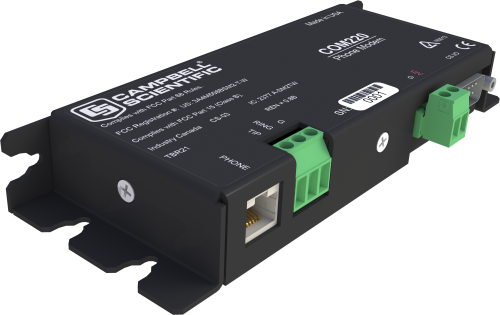
Low power use, wide operating temperature range






Overview
The COM220 phone modem enables communications between a computer and a Campbell Scientific data logger over a public switched telephone network. A Hayes-compatible modem is required at the computer site. The COM220 connects to the data logger at the field site. Most Campbell Scientific data loggers are compatible.
Read MoreBenefits and Features
- Wide operating temperature range and low power requirements make it ideal for use at remote sites
- Supports communication rates up to 115.2 kbps between modem and logger. (In practice, data transmission through phone lines is generally constrained to 33.6 kbps.)
- Compatible with most Campbell Scientific data loggers
- Offers both modem enabled (ME) and synchronous device communications (SDC) modes.
- Allows user to set the number of rings before answering call.
Images

Detailed Description
The COM220 has a CS I/O port, power terminals, screw terminals, and an RJ-11C jack. The data logger connects with the CS I/O port via an SC12 or SC12R-6 cable. The RJ-11C jack is for attaching a surge-protected telephone line. Alternatively, the screw terminals (GND, RING, TIP) can be used to connect the COM220 with a phone line via a surge protector.
Similar Products
Compatibility
Please note: The following shows notable compatibility information. It is not a comprehensive list of all compatible products.
Data Loggers
| Compatible | Note | |
|---|---|---|
| 21X (retired) | ||
| CR10 (retired) | ||
| CR1000 (retired) | ||
| CR1000X (retired) | ||
| CR1000Xe | ||
| CR10X (retired) | ||
| CR200X (retired) | ||
| CR206X (retired) | ||
| CR23X (retired) | ||
| CR295X (retired) | ||
| CR300 (retired) | ||
| CR3000 (retired) | ||
| CR310 | ||
| CR350 | ||
| CR500 (retired) | ||
| CR5000 (retired) | ||
| CR510 (retired) | ||
| CR6 | ||
| CR800 (retired) | ||
| CR850 (retired) | ||
| CR9000 (retired) | ||
| CR9000X (retired) |
Additional Compatibility Information
Phone Line/Surge Protection
Typically, a length of phone line is run from the telephone company's junction box to the COM220s surge protector, and then to the Ground, Tip, and Ring terminals on the COM220. Alternately, if adequate surge protection is provided by the telephone company and the junction box supports it, a length of telephone wire with RJ11C connectors (pn 2365) can be run directly from the junction box to the socket on the COM220.
Data Logger Considerations
Default settings are not compatible for non-PakBus data loggers (i.e., CR5000, CR7, retired data loggers). For these data loggers, the DIP switch settings must be changed; refer to the COM220 manual for details.
An SC12 cable is provided for connecting the COM220 with the data logger.
Software
LoggerNet and PC400 software packages support use of the COM220 with our data loggers. Both of these software packages support automated error-checking or user-initiated contacts. LoggerNet also supports scheduled contact times. Our software can run unattended allowing the user to take advantage of lower off-hour telephone rates.
Enclosure Considerations
The COM220 requires a desiccated, non-condensing environment; a Campbell Scientific enclosure is recommended. Grommets and screws are provided to attach the COM220 to the backplate of our enclosures.
Specifications
| Transmission Distance or Area | Worldwide |
| Operation | 1200 to 115200 baud digital communications over phone lines |
| Operating Voltage | 12 Vdc |
| Current Drain |
|
| Communication Rate | 9600, 38400, 57600, 115200 bps (between data logger and COM220, and selected by user) |
| Operating Temperature Range | -25° to +50°C (standard) |
| Standards | V.92, K56Flex, V.90, V.34, V.32bis, V32, V23, V22bis, V22, V.21, B212, B103 |
| Registration |
|
| Service Requirements | If not available at the site, phone lines must be installed. |
| Dimensions | 16.5 x 2.5 x 6.6 cm (6.5 x 1.0 x 2.6 in.) |
| Weight | 0.16 kg (0.35 lb) |
Related Documents
Product Brochures
Manuals
Compliance
Downloads
COM220 OS v.05 (671 KB) 23-11-2011
Execution of this download installs the COM220 Operating System on your computer.
Note: The Device Configuration Utility is used to upload the included operating system to the COM220.
FAQs for
Number of FAQs related to COM220: 14
Expand AllCollapse All
-
Cable runs of that length usually will require a booster of some sort. Contact the local phone company for recommendations.
-
All data loggers will work with the COM220 except the CR200X-series dataloggers.
-
No. The COM220 is designed to pick up a call and cannot be overridden. A better approach would be to use a phone line sharing device. Note that the phone line sharing device must simulate a normal phone line accurately or it won’t work correctly with the COM220.
One phone line sharing device that has been used successfully by our customers is “The Stick” by Multi-Link. This device takes one incoming phone line and breaks it out to four separate lines. It does require ac power to run. For more information, refer to the Multi-Link website.
-
Refer to the “Installation” section of the COM220 Telephone Modem Instruction Manual.
-
There are several possibilities as to the cause. Contact Campbell Scientific for assistance in determining the specific cause.
-
Not directly. A data logger needs to be used with it, and the remote caller needs to be running LoggerNet or PC400.
-
Typically, software such as LoggerNet or PC400 is needed to connect to a data logger and download the data.
-
The COM220 and the radio can coexist on the CS I/O port provided that they are assigned two different SDC addresses.
